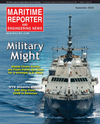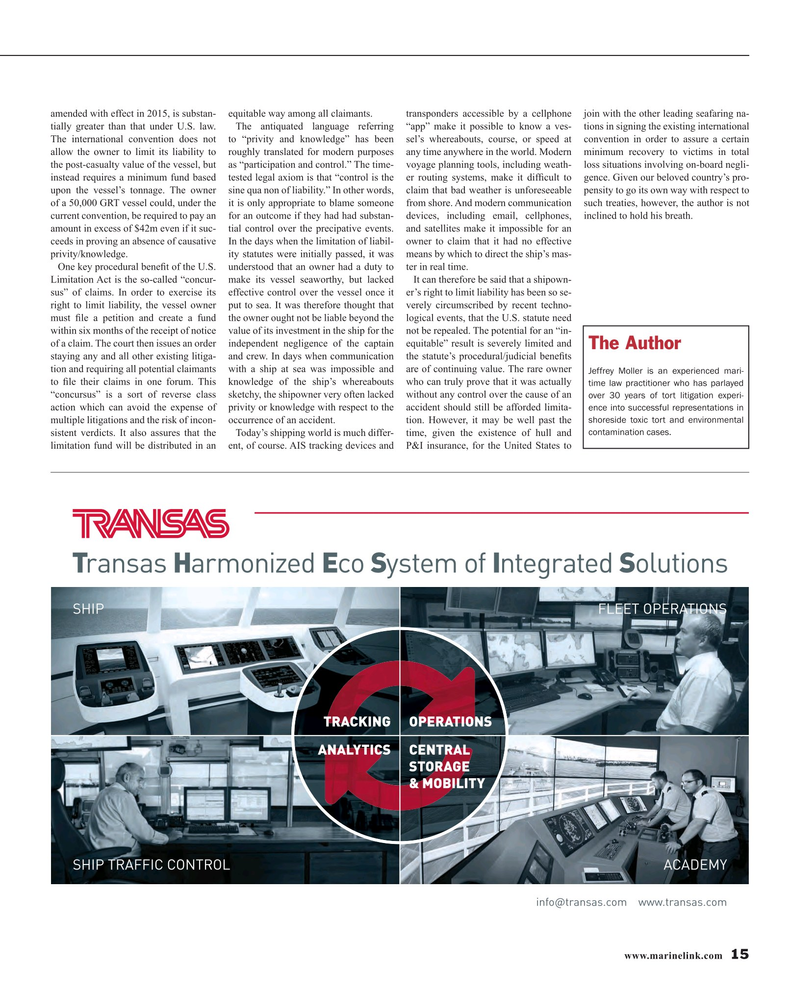
Page 15: of Maritime Reporter Magazine (September 2016)
Maritime & Ship Security
Read this page in Pdf, Flash or Html5 edition of September 2016 Maritime Reporter Magazine
amended with effect in 2015, is substan- equitable way among all claimants. transponders accessible by a cellphone join with the other leading seafaring na- tially greater than that under U.S. law. The antiquated language referring “app” make it possible to know a ves- tions in signing the existing international
The international convention does not to “privity and knowledge” has been sel’s whereabouts, course, or speed at convention in order to assure a certain allow the owner to limit its liability to roughly translated for modern purposes any time anywhere in the world. Modern minimum recovery to victims in total the post-casualty value of the vessel, but as “participation and control.” The time- voyage planning tools, including weath- loss situations involving on-board negli- instead requires a minimum fund based tested legal axiom is that “control is the er routing systems, make it dif? cult to gence. Given our beloved country’s pro- upon the vessel’s tonnage. The owner sine qua non of liability.” In other words, claim that bad weather is unforeseeable pensity to go its own way with respect to of a 50,000 GRT vessel could, under the it is only appropriate to blame someone from shore. And modern communication such treaties, however, the author is not current convention, be required to pay an for an outcome if they had had substan- devices, including email, cellphones, inclined to hold his breath.
amount in excess of $42m even if it suc- tial control over the precipative events. and satellites make it impossible for an ceeds in proving an absence of causative In the days when the limitation of liabil- owner to claim that it had no effective privity/knowledge. ity statutes were initially passed, it was means by which to direct the ship’s mas-
One key procedural bene? t of the U.S. understood that an owner had a duty to ter in real time.
Limitation Act is the so-called “concur- make its vessel seaworthy, but lacked It can therefore be said that a shipown- sus” of claims. In order to exercise its effective control over the vessel once it er’s right to limit liability has been so se- right to limit liability, the vessel owner put to sea. It was therefore thought that verely circumscribed by recent techno- must ? le a petition and create a fund the owner ought not be liable beyond the logical events, that the U.S. statute need within six months of the receipt of notice value of its investment in the ship for the not be repealed. The potential for an “in- of a claim. The court then issues an order independent negligence of the captain equitable” result is severely limited and
The Author staying any and all other existing litiga- and crew. In days when communication the statute’s procedural/judicial bene? ts tion and requiring all potential claimants with a ship at sea was impossible and are of continuing value. The rare owner
Jeffrey Moller is an experienced mari- to ? le their claims in one forum. This knowledge of the ship’s whereabouts who can truly prove that it was actually time law practitioner who has parlayed “concursus” is a sort of reverse class sketchy, the shipowner very often lacked without any control over the cause of an over 30 years of tort litigation experi- action which can avoid the expense of privity or knowledge with respect to the accident should still be afforded limita- ence into successful representations in shoreside toxic tort and environmental multiple litigations and the risk of incon- occurrence of an accident. tion. However, it may be well past the contamination cases.
sistent verdicts. It also assures that the Today’s shipping world is much differ- time, given the existence of hull and limitation fund will be distributed in an ent, of course. AIS tracking devices and P&I insurance, for the United States to www.marinelink.com 15
MR #9 (10-17).indd 15 9/6/2016 1:43:58 PM

 14
14

 16
16
